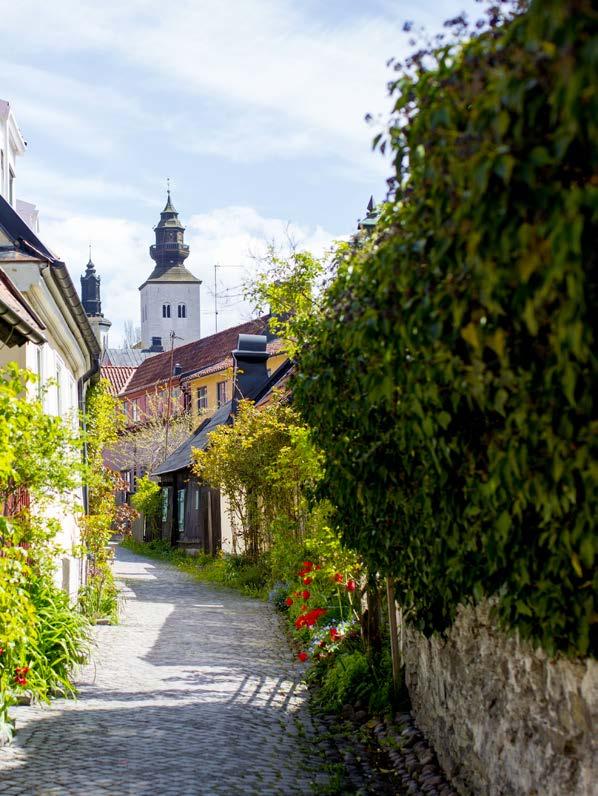
5 minute read
A runestone’s fate and adventures
ILLUSTRATION: JOHAN GÖRANSSON
In University Park, Uppsala, there are a number of Viking-era runestones, all originating from Uppland – by far Sweden’s runestone-richest province with close to 1,300 inscriptions – and all with their own story to tell. Perhaps one of them in particular? This is the story of the special Örby Stone’s fate and adventures from the Viking era to the present day.
TTHE STONE WAS originally erected in the eleventh century by a man named Vigmund in Örby in the parish of Rasbo east of Uppsala. According to the inscription, he was a ship’s captain who, together with his wife Åfrid, commissioned the stone to commemorate himself. It also states that, in his own estimation, he was “the most skilful of people”. Here the stone stood beside the road for several centuries until, one day in 1628, it was shipped from Örby to the garden of the linguist and historian Olof Verelius on Övre Slottsgatan in Uppsala, to be used in his teaching.
ON VERELIUS’S DEATH in 1682, the famous Uppsala resident Olof Celsius had the stone moved to his own garden on Östra Ågatan. Olof Celsius the elder – who was related to the famous inventor of the temperature scale, Anders Celsius – was a versatile fellow. He was professor, successively, of Greek, Oriental languages and theology. Finally, in 1736, he became dean of the cathedral. Apparently, his interests also stretched to runestones. The Örby Stone was joined in his garden by two more runestones from Uppland.
THERE THEY ALL remained until 1867 when they were lent to the Paris International Exposition. The Örby Stone and the two
i
The Örby Stone

2

International Exposition of 1867 held on the Champ de Mars in Paris, France. Anonymous – Le Monde illustré 1867. Public Domain
other stones from Olof Celsius’s garden proved to be a great success among the nearly one million visitors to the exposition, where they were awarded a bronze medal.
WHEN THE INTERNATIONAL Exposition closed, the runestones were to be returned home to Uppsala by boat from Le Havre on the French coast; however, while being loaded on board, the heavy Örby stone plunged into the water. Recovery was deemed impossible and instead Uppsala University claimed 200 kronor on its insurance policy and the stone was left in the murky depths of the French harbour. BUT THAT WAS not the end of the Örby Stone’s story. Some 30 years later in the 1890s, when the harbour of Le Havre was being dredged, an excavator fished up a large stone covered with ‘strange’ symbols. The salvaged Örby Stone could now be safely and securely shipped back to Uppsala, where it was placed in the Linnaeus Garden on Svartbäcksgatan.
IT WAS NOT UNTIL 1949 that the Örby Stone was reunited with its two fellow runestones from the Paris exposition when, together with six others, they were erected in the University Park in front of Gustavianum, Uppsala University Museum, where they can
3 – Anna Malmberg
• The stone was carved in the eleventh century. Both sides are marked with a cross, dating the stone to the late Viking era. The runes on the stone’s right-hand side are reversed.
• Inscription, standardised to Runic Swedish: “Vigmundr let haggva stæin at sik sialfan, sløgiastr manna. Guð hialpi sial Vigmunda styrimanns. Vigmundr ok Afriðr hioggu mærki at kvikvan sik”
• English translation: “Vigmund had this stone carved in commemoration of himself, the most skilful of people. God save the soul of the ship’s captain Vigmund. Vigmund and Åfrid carved this memorial while he lived.”
Source: The strange story of the Örby Stone can be read in the book Runestones: a colourful memory.
still be viewed today.
1

Olof Celsius the elder. The runestone in front of the orangery in the Linnaeus Garden, home of the Museum of Nordic Prehistory during the late nineteenth and early twentieth centuries.
Illustration showing what the pendulum will look like.

Christine Mackay Tircomnicu, lecturer at the Department of English, who was awarded the 2020 Free Distinguished Teaching Award on the theme of feedback to students.
The Ångström Laboratory will soon have a new attraction in one of the buildings currently under construction on campus: Foucault’s pendulum.
This installation has been made possible by a private donation by Johan Tysk, Vice-Rector of the Disciplinary Domain of Science and Technology.
“I have always been fascinated by Foucault’s pendulum. It is a magical contraption that makes us feel part of something greater,” says Tysk.
The pendulum consists of a heavy bob that swings from a 28-metre-long wire attached to the ceiling. Its movement proves that the earth rotates around its own axis. It is an illustration of the interplay between science and technology. The pendulum is named after Jean-BernardLéon Foucault, the French physicist who first demonstrated the experiment in 1851. It will however be some time before we can experience the pendulum in the Ångström Laboratory, as the building will not be completed until 2022.
50,000 admissions
An unusually large number of students were admitted to Uppsala University in the autumn of 2020. In all, almost 50,000 admissions were made to the nearly 140 programmes and more than 2,000 courses. That is 4,000 more admissions than in the autumn of 2019.
77
77th, that is Uppsala University’s place in the new ranking of world universities recently published by the Shanghai Ranking Consultancy. The 2020 Academic Ranking of World Universities (ARWU) ranks Uppsala University in 77th place in the top 100 list, the third highest ranking among Swedish universities after Karolinska Institutet in 45th place and Stockholm University in 69th.










